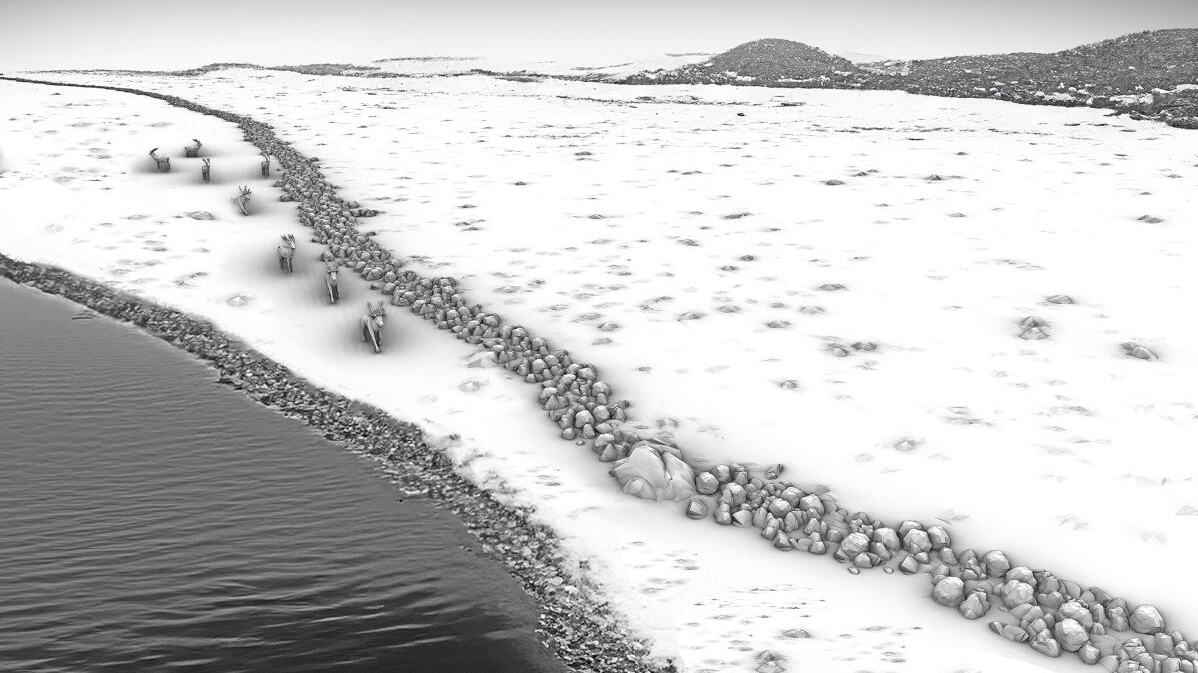The location
A research team from the Christian Albrechts University in Kiel (CAU) actually wanted to examine manganese crusts on a marl ridge that lies about 10 km off Rerik at the bottom of the Mecklenburg Bay. They became aware of a 970 m long, regular stone structure. This consists of up to 1,500 stones the size of tennis to football, which connect several large boulders to form a wall up to 1 m high. The researchers reported their discovery to the Mecklenburg-Western Pomerania State Office for Culture and Monument Preservation (LAKD MV), which coordinated further investigations.
The site is on the southwestern edge of the marl ridge. The stone wall here runs parallel to a depression, probably a former lake or moor. The Baltic Sea is now 21 meters deep at this point. The stone wall must therefore have been built before the water level rose sharply after the end of the last ice age. This last happened about 8,500 years ago. Large parts of the landscape that had previously been accessible were flooded.
Scientists from the Leibniz Institute for Baltic Sea Research Warnemünde (IOW), the CAU research focus Kiel Marine Science, the University of Rostock, the Center for Baltic and Scandinavian Archeology in Schleswig, which has been part of the Leibniz Center for Archeology (LEIZA) since 2024, the German Aerospace Center (DLR), the Alfred Wegener Institute, Helmholtz Center for Polar and Marine Research (AWI) and the LAKD MV have created a detailed 3D model of the wall and the structure using modern geophysical methods of the surrounding subsoil reconstructed. Using sediment samples from the basin adjacent to the south, the possible age of formation of the linear structure was narrowed down. In addition, investigations were carried out by research divers from the universities of Rostock and Kiel in order to get a precise picture of the situation on the seabed.
The results so far
“The investigations have confirmed that a natural origin is just as unlikely as a construction in modern times, for example through construction work to lay submarine cables or stone fishing. The stones are arranged too systematically and regularly for that,” explains Jacob Geersen, first author of the study published in the renowned journal “Proceedings of the National Academy of Sciences” (PNAS). As part of the new IOW research focus “Shallow water processes and their relevance for the entire Baltic Sea”, he is working on geological and anthropogenic processes in the Baltic Sea region.
If natural or modern origins are ruled out, the only time for the stone wall to be built is after the end of the last Ice Age (around 12,000 years ago), when the landscape was not yet flooded by the Baltic Sea. “It is assumed that no more than 5,000 people lived in the whole of Northern Europe at this time. One of the main foodstuffs of these groups was reindeer, which traveled in herds in seasonal rhythms through the low-vegetation post-glacial landscape. The wall probably served to keep the reindeer on the edge of a “To corner the lakes so that they could be killed by the Stone Age hunters with hunting weapons,” explains Marcel Bradtmöller from the University of Rostock.
Such hunting techniques have already been demonstrated several times in other parts of the world. American archaeologists have found stone walls 30 m deep in Lake Huron (Michigan) that were demonstrably built for the hunt of caribou, the North American counterpart of the reindeer. The stone walls in Lake Huron and Mecklenburg Bay have great similarities.
Since around 11,000 years ago, when the climate became warmer and forests expanded, the last migratory herd animals disappeared from our latitudes along with the last reindeer, the stone wall is unlikely to have been built after this point in time. The stone wall would be the oldest human structure ever discovered in the Baltic Sea. “Although numerous well-preserved archaeological sites from the Stone Age are known in the Wismar Bay and along the coasts of Mecklenburg-Western Pomerania, these are located at significantly shallower water depths and mostly date to the Middle and Neolithic Ages (approx. 7,000 – 2,500 BC) “, explains Jens Auer from the Mecklenburg-Western Pomerania State Office for Culture and Monument Preservation, who was involved in researching and sampling many of these sites.
The stone wall and the surrounding seabed will be examined in more detail using side-view sonar, sediment echo sounder and multi-beam echo sounder. “In addition, we now have evidence that suggests the existence of comparable stone walls elsewhere in the Mecklenburg Bay. We will systematically explore these,” explains Jens Schneider von Deimling, from the University of Kiel. Further dives by the University of Rostock and by employees of the Mecklenburg-Western Pomerania State Office for Culture and Monument Preservation are also planned to search the stone wall and its surroundings for archaeological finds that can help with interpretation.
The aim is to use the luminescence method to date the stone wall. This method can be used to determine when the surface of a stone was last exposed to sunlight. A detailed reconstruction of the surrounding landscape is also planned. Overall, the investigations can make a significant contribution to the understanding of the early Stone Age foraging groups and help to understand their way of life, organization and hunting methods.
